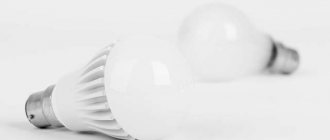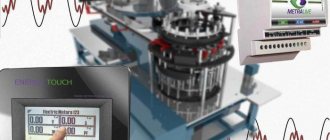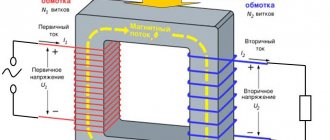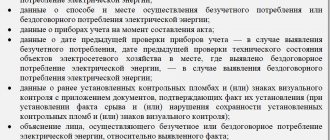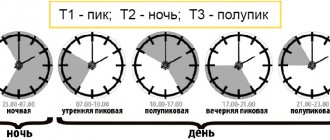Standard power ratings for an electric stove
Currently, there are classic stoves - with traditional burners. The heating element is a spiral. They heat up and cool down quite slowly. Glass ceramics heats up more evenly and takes less time to cool down. The efficiency of such household appliances is quite low.
Cookers with induction burners are also available. In them, heating occurs due to vortex flows, which are formed by a high-frequency magnetic field of 20–100 kHz. In this case, it is not the burner that heats up, but the dishes sitting on it. The working area is heated to a maximum of 60 degrees. This is its significant advantage, since it is impossible to get burned when using such equipment.
The power consumption of appliances increases with the number of burners and their diameter, and this figure is also affected by the presence of other heating elements:
- 2 cast iron burners will take 2000 W;
- 4 – from 5000 W;
- 4 burners with induction heating may require from 10400 W.
But this is provided that you have to use all the burners at the same time, and this happens extremely rarely - only when you need to cook a large amount of food. Usually one or two work.
Electric stove power and energy consumption
A typical electric stove with four cast iron burners can consume between 4kWh and 8kWh. These figures are calculated under the condition that all four burners of the electric stove are turned on simultaneously. However, not all burners are always turned on at the same time, therefore, energy consumption is reduced.
If you use the features of this type of electric stove correctly, you can save additional money. To fully utilize the heat coming from the burners, the bottom of the pan and the diameter of the burner must match; a flat bottom of the pan will also improve heat transfer. It should be borne in mind that cast iron burners retain heat for a long time and can be turned off a few minutes earlier, while the cooking process will continue.
Knowing the approximate energy consumption of various elements of an electric stove, you can use it more optimally and save energy.
- The power of electric burners 145 mm in diameter is approximately 1.0 kW.
- The power of electric burners 180 mm in diameter is approximately 1.5 kW.
- The power of electric burners 200 mm in diameter is approximately 2.0 kW.
- The power of the upper heating element is approximately 0.8 kW
- The power of the lower heating element is approximately 1.0 kW.
- Lighting power is approximately 15.0 - 25.0 W.
- The power of the heating element on the grill is approximately 1.5 kW.
- The motor power on the spit is approximately 6 W.
The most energy-consuming is the large burner, but do not forget that its operation lasts less time, since heating occurs more intensely.
Despite the fact that the electric stove is a high-power device, manufacturers are trying in every possible way to reduce energy consumption. Electric stoves, like other household appliances, are divided into energy consumption classes. The most economical is class A, in which there is also competition between A and A, which positions itself as the most economical.
A special place among electric stoves is occupied by stoves with induction burners. These devices are distinguished by even higher power, as well as high cost. However, if an induction electric stove is used correctly, its energy consumption will be much less than that of a stove with electric burners.
Due to its high power, an induction electric stove heats food very quickly during cooking, has an automatic shutdown immediately after removing the dishes from the burner, and when using special cookware, there is no loss of heat. Due to all this, despite the high power, the electricity bills for those who use an induction cooker will be significantly lower than for those who use an electric cooker with other types of burners.
How power affects operation and energy consumption
When choosing a stove, you should take into account that its power will affect the heating speed and the number of fully functioning burners at the same time. The oven will require the most energy. But high-quality oven insulation will reduce the loss of electricity and money.
The user can optimize the electrical energy consumption of his stove if:
- will use dishes with a flat bottom - this will improve heat transfer between the burner and the pot or pan;
- will cook food in a saucepan or frying pan with a diameter approximately equal to the diameter of the burner;
- When using a stove with cast iron burners, turn it off before the cooking is finished - cast iron retains heat for a long time and after turning off the food will continue to cook for some time.
Many people ask the question: “How many kilowatts does an electric stove consume?” The approximate amount of energy that, on average, a household appliance will consume per month is:
- motor installed on the grill spit – 6 W;
- oven lighting – 15.0–25.0 W;
- burner with a diameter of 14.5 cm – 1.0 kW;
- with a diameter of 18.8 cm - 1.5 kW;
- diameter 20 cm – 2.0 kW;
- upper and lower heating elements in classic stoves 0.8 and 1.0 kW, respectively;
- The heating element installed on the grill in the oven is 1.5 kW.
A large burner requires the most energy to operate, but its heating rate is significantly higher than burners of a smaller diameter.
REFERENCE! Currently, manufacturers label all household appliances according to economic efficiency classes. The less energy required to achieve a given temperature, the higher the class. The marking is indicated in English letters: A, B, C... G. At the same time, the marking “A” indicates high energy efficiency. There were even classes A+, A++ and A+++. This is a label designation for the most cost-effective household appliances. Modern stove models can be cheaper to operate than outdated ones.
Induction hobs use more power. But there are advantages that allow you to save money when using the device correctly:
- When using not only special cookware, but also cookware with ferromagnetic properties (this includes even outdated enamel-coated pans), less heat loss occurs. If the magnet attached to the bottom of the container sticks, the cookware is suitable for induction heating.
- Quickly removing the pot or pan from the stove will also save money, because in this case the burner immediately stops heating.
- Some options that can be equipped with an induction heating stove also provide the opportunity to save money: auto shut-off when boiling, timer.
To operate 4 induction burners, up to 7 kW is most often required. 3–5 kW is consumed for heating. It should be noted that heating such a stove takes half the time.
They are usually equipped with a display. It displays modes and power levels. Thanks to the low temperature of the working surfaces, nothing will burn to such a stove. Therefore, it is easy to keep clean. If you try to use a cookware with a diameter that is very different from the diameter of the burner, it will not turn on. It won’t turn on when you try to place dishes with a diameter of less than 100 mm on it.
REFERENCE! There are also combined plates. They have induction-heated burners with installed heating elements. In them, as in any other equipment, the power consumption will be specified in the technical instruction manual.
Standard power ratings
Most mini ovens range from 650 to 3500 watts. Such indicators provide the necessary thermal energy and the functioning of additional elements. The most common group of mid-priced compact ovens with top and bottom heaters consumes from 1.2 to 2.5 kW. Individual structural elements differ in energy consumption:
- upper and lower heating elements - 0.8-1 kW each;
- grill – 1.5 kW;
- rotisserie motor and internal lighting – 20-25 W;
- external burner – 1.5 kW.
For more expensive models, energy efficiency is affected by better thermal insulation of the main chamber. This parameter determines how quickly the stove cools down during cooking. You can also reduce energy consumption if:
- turn off the oven 10-15 minutes before the end of cooking;
- use dark dishes;
- Do not let the unit cool down while preparing several dishes one after another.
Calculation of the power of electric ovens for the home depends on the composition of the family and the frequency of cooking. There is no point in buying a powerful, expensive model if its functions are used very rarely.
How to choose an electric stove
Sometimes there are times when you need to purchase a small, compact electric stove. And it doesn’t matter whether you need it for rare use in the country or for constant home cooking - you can choose a completely functional device.
Small table tiles become a real salvation in certain situations. Sometimes electric stoves are installed in gasified apartments as a backup option in case of gas outage. This is an excellent solution for those who live in cramped conditions when there is nowhere to put large kitchen appliances - for example, in dorm rooms or apartments that are not equipped with a spacious kitchen. Compact stoves are an excellent option in country houses and cottages, where a full-fledged stove with oven is simply not needed.
Light weight, modest size, absolute mobility and ease of storage combined with classic functionality – these are the most important features of tabletop electric stoves. They come in either one or two burners and can be made of different materials. All you have to do is choose the one that best suits your needs.
Burners and panel covering
The type of burners directly depends on the material from which they are made.
The most classic type, familiar to everyone, is open spiral. Typically these burners are made of stainless steel. The heating element is located inside a steel spiral. The advantage is that spiral tiles are generally quite inexpensive. But if you intend to cook on the stove frequently and constantly, then this is not the best option.
Firstly, the spiral heats up, although quite quickly, but not always evenly and also cools unevenly. On average, spiral burners have a shorter lifespan compared to other types. In addition, they are more demanding to care for - the spiral itself is not particularly convenient to clean, much less to wash out any trapped food residues and stains underneath it. Even though in modern models the burners can be raised to clear the space underneath them. However, if you don’t need the stove very often, and you don’t want to overpay, this is an excellent option.
Closed disc burners are also a kind of classic. Made of cast iron, under which the heating element is located. Over time, cast iron accumulates carbon deposits and undergoes rust formation. Closed burners are usually convex, making the rims around the heating disc the main concern for cleaning. But in general, the operation of this type of burner is quite convenient.
Glass ceramics is a modern solution in the production of both tiles and hobs. The first thing people love about glass ceramics is convenience in every sense. These burners are completely smooth and do not have any rims, extra bulges or seams where dirt can become clogged and inconvenient to clean. And in general, the glass-ceramic material itself is very grateful - neither grease nor carbon deposits stick to it, and no rust forms. Perhaps scratches may appear over time, but it all depends on your accuracy. Again, there is no risk of knocking over hot dishes from the stove, since the surface is completely flat.
Glass-ceramic burners often have expanded functionality - they are dual-circuit with an expanded heating zone and increased power for instant heating. But glass ceramics are not suitable for “camping” conditions. Still, the material is fragile, does not tolerate mechanical damage, falls and requires attention. By the way, if the burners are made of glass ceramics, then the entire tile panel is usually made of it.
The stove panel can also be made of stainless steel or enameled steel. The first option is more wear-resistant. If you are looking for a device for your garden or are not sure that you are ready to carefully clean the tiles, blowing away dust particles, stainless steel is an excellent option. Enamel is susceptible to scratches and chips, due to which rust gradually forms and, in general, the aesthetic appearance is lost. But with careful care, enamel retains its properties for a long time.
How does it affect work and energy consumption?
How much electricity an electric stove takes depends primarily on its type: it can be classic or induction. Secondly, this is influenced by the number of functions that are built into the stove and, finally, by the type of heating elements used in it.
To calculate the electricity consumption of a stove, two quantities are needed: the power of the heating elements and the duration of their operation.
Classic electric stoves using conventional heating elements (tubular electric heaters), for example, with a power of 1 kW consume 1 kW x 30 minutes = 300 kWh in half an hour. Knowing that kWh prices vary in different Russian regions, you can take the average cost as 4 rubles. This means that it turns out 0.5 kWh x 4 rubles. = 2 rub. This is the price for operating the stove for a quarter of an hour.
By testing you can also find out the amount of electricity consumed by an induction electric stove: taking, for example, a heating element with 1 kW of power, in a quarter of an hour of operation such an electric stove will consume electricity in the same amount as a classic one, but induction stoves have a big advantage - their efficiency 90%. It is so large because there is no leakage of heat flow (almost all of it is usefully used). This significantly reduces the operating time of the electric stove. Another advantage is that the burners automatically switch off as soon as the cookware is removed from them.
Some manufacturers focus on producing combined stoves that combine induction heating burners with heating elements in their design. For such stoves, when calculating power, special attention must be paid to the technical documentation, since the power of different types of heating elements can vary significantly.
Of course, an electric stove is one of the most voracious consumers of electricity in an apartment. Typically, its energy consumption depends on the number of burners - their power ranges from 500 to 3500 W. Using simple calculations, you can obtain a consumption of 500-3500 W of electricity per hour per burner. Experience shows that in 24 hours an average family spends about 3 kW, which in a month will amount to 30-31 kW. This value, however, can increase to 9 kW, but this is at maximum load on the stove, for example, on holidays.
Of course, this value is approximate and depends not only on the load, but also on the model, whether the stove has additional functions, and the class of electricity consumption.
The energy consumption of a stove depends not so much on its properties, but on how it is used. Tips include information on ways to save money.
- As a rule, it is not necessary to use the highest heat setting when cooking. It is quite enough to bring the contents of the pan to a boil and then reduce the temperature level to the minimum. In any case, it will not be possible to heat food above 100°C, and the energy constantly released for boiling will lead to the liquid constantly evaporating. It has been experimentally proven that in this case you will have to pay for an additional 500-600 W of electricity for each liter of liquid (if the pan lid is open).
- It is advisable to cook food that requires a long time to cook on small-diameter burners with a minimum level of electricity consumption. In general, using this tip can save you a huge amount of money. It is for this reason that today almost every electric stove burner is equipped with a special temperature level regulator, which allows you to reduce energy costs by 1/5. To a large extent this applies to the so-called stepless type regulators, which allow you to increase/decrease the power level of the heating elements from 5% to a maximum. There are also stoves where the built-in equipment automatically controls the power level depending on how hot the bottom of the cookware on the burner is.
- When operating an electric stove, it is recommended to use special dishes that have a thick bottom that is as close as possible to the working surface of the stove. This improves heat transfer to the cookware.
Power and functionality
How well the stove will heat up directly depends on its power. This parameter can vary from very economical models less than 1 kW to powerful devices over 5 kW.
On average, spiral and cast iron stoves consume up to 1.2 kW per burner. Accordingly, for two burners – about 2 kW. Glass-ceramic ones are often more powerful. Among them you can even find single-burner 2 kW models. Usually, for comfortable cooking, no more than 1–1.5 kW per burner is enough. If you like to cook quickly and at high temperatures, choose a more powerful device, but check that your sockets and electrical networks can withstand such a load.
The main functionality during cooking is determined primarily by the number of heating modes and the diameter of the burners.
The number of heating adjustments depends on the models. For glass ceramics there can be up to 7–8 of them, since such burners heat up and cool down very quickly, and the difference in modes is noticeable. For spiral and disc burners, as a rule, 3–4 modes are sufficient.
By the way, induction cookers stand apart in heating systems. They work on the principle of a magnetic field and are distinguished, firstly, by instant heating, and, secondly, they heat the dishes directly, while the burners themselves remain completely cold. On the one hand, induction hob models are more productive, more comfortable and safer than all others. But they require special dishes with a ferromagnetic bottom.
When talking about the size of the burners, start from the tasks. If you're looking for a camp stove and plan to use it infrequently, a medium- or large-sized single-burner model may be sufficient. Suitable for most types of cookware and, at the same time, smaller than 2-burner options.
For constant cooking, the best option is two burners of different sizes. It is not recommended to use small ladles or saucepans on large burners. Conversely, if you place a large, wide pan on a small burner, you will wait too long for the dishes to warm up. In addition, there is a risk of this pan turning over due to poor stability.
The typical diameter of the burners is about 14.5 cm for small ones, 16–18 cm for medium ones and 19–21 cm for large ones.
Glass-ceramic tiles are very convenient in this matter, since they are often equipped with a double-circuit zone - you can change the heating diameter depending on the cookware used. Sometimes the expanded zone can even have an oval shape.
Electric stove power: standard indicators, how much it consumes per month
Electric stove
Let's say we cook for an hour every day during the work week. We spend 20 minutes for breakfast, 40 minutes for dinner and preparing lunch for tomorrow.
But on the weekend we’ll let the stove work for 2.5 hours a day, because we need to cook a nice big dinner for the family. And breakfast usually takes a long time to prepare on weekends.
Finally, you need to prepare lunches and dinners for the work week.
- Let's take into account that usually all four burners are not used at the same time and do not heat up constantly, but, having reached the desired temperature, turn off, so we will conventionally assume that only 2 burners are working at the same time and at 2/3 of the power.
- Question answer
- Does it make sense to unplug appliances to save energy?
The power of electric stoves ranges from 4 to 8 kW. Let's take 6 kW for calculations.
That is, the stove will consume about 0.9 kWh. Per week - 9 kWh, per month - 38.5.
Induction cookers generally cannot be included in these average calculations, since with much higher power they consume less electricity due to the speed of cooking and overall efficiency.
Oven
Let's assume that we cook 2 dishes in the oven 2 times a week. For example, a pie and some kind of baked meat. The pie will cook for about an hour, the meat - 1.5-2 hours. Let's round it up to 3 hours per week. The average energy consumption of the oven is 0.8 kWh. That is, we will use 2.4 kWh per week in the electric furnace, and about 10 per month.
Life without a stove. What equipment can replace the hob and oven Read more
Types of slabs
Electric stoves are classified according to the following indicators:
- material of working areas (cast iron, spiral or glass ceramics);
- method of adjustment (sensory or mechanical);
- power supply (1-phase or 3-phase).
Induction heating plates can be considered separately.
This electric stove uses innovative technology - it heats not the thermoelement material, but the bottom of the cookware, and from there the temperature transfers to the working area of the burner.
Such electric stoves are more powerful than classic ones, they are also more expensive, but with proper and competent operation there is a serious opportunity for great energy savings, since:
- The stove heats up quickly;
- heating is automatically switched off when dishes are removed from the burners;
- You can use dishes that prevent heat loss.
Electricity consumption
Every extra kilowatt consumed costs the user a pretty penny, so it is important to use the stove correctly. When using all the functions of an electric stove simultaneously, from four to eight kilowatts are consumed. To avoid paying extra, use your electrical appliance wisely:
- Correct selection of pans will help prevent heat loss: the diameters of the burner and the bottom of the pan should be the same size;
- It is preferable to use dishes with a flat, level bottom;
- It is important to cover the dishes with a lid;
- If the stove is equipped with a cast-iron burner, turn it off before removing the dishes; after turning off, the device will continue to give off heat for some time.
Induction cooker
To save, you need to have an idea of how much electricity each element of the stove consumes:
- A burner with a diameter of 14, 5, 18 or 20 cm consumes 1, 1.5 and 2 kilowatts, respectively.
- Grill, lower, upper heating elements consume 1.5, 1 and 0.8 kilowatts per hour, respectively.
- The oven consumes from 3 to 4 kilowatts per hour.
Among gas, induction and electric surfaces, induction consumes the least. In comparison, heating the same amount of water with two types of stoves gives the following result:
- Electric stove - it will take about twenty minutes, one and a half kilowatts will be spent.
- Induction hob – four minutes, less than half a kilowatt will be spent.
In terms of a month with moderate use of the device, the numbers will be as follows:
- Electrical panel - about four hundred and eighty kW/hour;
- Induction panel - about one hundred and fifty kW/hour.
How to save electricity
By following a few simple rules, you can reduce energy costs when cooking on the stove.
- The bottom of the dish must be perfectly flat. The better the diameter of the cookware matches the burner, the higher the efficiency (efficiency).
- The classic stove is inertial. It should be turned off a few minutes earlier; due to the accumulated heat, it will continue to cook for another 2-5 minutes.
- Choose energy-efficient equipment (class A, A+).
A simple electric stove costs much less than an induction stove. However, in the long term, purchasing induction is justified. Significant savings in expensive energy over many years will offset the price difference.
additional characteristics
Compact electric stoves have rather simplified functionality. Features include, for example, various protection systems. This could be a child lock on the panel (usually on glass-ceramic hobs), overheat protection, or automatic shutdown in case of overvoltage.
The type of device control usually varies depending on the design. Thus, disc and spiral tiles are usually controlled using clock and rotary mechanisms, and glass ceramics are often equipped with a sensor or buttons.
Glass-ceramic hobs sometimes have a residual heat indicator. It shows in real time the degree of cooling of the burners after switching off. The indicator is on - the burner is still hot, when it goes off - it has cooled down to a touchable 50 °C.
The timer allows you to automate and greatly simplify the cooking process - the stove will turn itself off after a specified period of time, and you will not need to remember about the dish.
Standard power parameters
Despite preferential tariffs for owners of non-gasified housing, the operating costs of maintaining an electric stove are quite high. The higher the power of the electric stove, the higher the amount in the bills for the energy used. A classic four-burner hob (2 with a diameter of 180 mm; two with a diameter of 145 mm) consumes (on average) 5 kW/h. An induction cooktop has higher electricity consumption. This value can reach 10.5 kW when all four burners are used simultaneously.
Types of stoves and energy consumption
The energy consumption of electric stoves depends not only on the number and diameter of the burners, but also on the type and operating principle of the heating element. Today, two types of electric stoves are available to consumers.
How much electricity does an electric stove consume?
When purchasing an electric stove, consumers pay attention not only to the functionality of the product, but also to how much electricity will be consumed during operation. Currently, almost all manufacturers of household appliances have developed special stickers containing information about electricity consumption.
How is energy consumption determined?
Electricity consumption by an electric stove depends on the type of electric stove, classic or induction type. Electricity consumption is also affected by the saturation of the stove with functions and heating elements.
To calculate the electricity consumption of an electric stove, you need to know the power of the burners and the time allotted for operation.
A classic electric stove with conventional heating elements (tubular electric heaters) with a power of 2 kW in 15 minutes will consume energy from the electrical network equal to 2 kW ⋅ 0.25 h = 0.5 kW/h. Considering that the price for 1 kWh varies across Russian regions, the average value will be 4 rubles. That will turn out to be 0.5 kW/h x 4 rubles. = 2 rubles - the cost of operating an electric stove for 15 minutes.
By testing and the values of the passport characteristics, you can find out how much electricity an induction-type electric stove consumes. The Endever IP-11 induction hob is used as an example. Having a 2 kW burner, in 15 minutes of operation the stove will consume the same amount of electricity as a classic one. But there is a significant advantage: due to the absence of heat flow leakage past the dishes, the efficiency increases to 90%, and accordingly, the operating time of the stove decreases. Another plus in favor of saving energy is that when you remove dishes from the stove, the hob automatically turns off.
Proportionality of power and energy consumption
Electricity consumption directly depends on the time of use and the power of consumers of the electric stove. The energy consumption of each element is normalized and is in the following ranges:
- Cast iron burner with a tubular heating element from 1 to 2 kW/h.
- The upper heating element of the oven is 0.8 kW/h.
- The lower heating element of the oven is 1 kW/h.
- Grill with tubular electric heater - 1.5 kW/h.
- Oven lighting - from 0.015 to 0.025 kW/h.
- The rotisserie motor is 0.006 kW.
How much electricity does a full-fledged four-burner induction cooker consume? In the classic version, the induction hob is equipped with two burners with a diameter of 160 mm, and one with a diameter of 180 mm.
The largest has a diameter of 210 mm. Power:
- 160 mm - 1.5 kW;
- 180 mm - 2 kW;
- 210 mm - from 2.5 to 3.5 kW.
The total energy consumption of the hob when all burners are operating at full power ranges from 7.5 to 8.5 kW/h.
On a note! To understand the upcoming operating costs, you can make a simple calculation. To do this, you need to multiply the following values: the total power of all consumers of the electric stove (kW); time of use (h), cost of 1 kW of electricity according to your tariff.
Electricity consumption for household appliances
Energy consumption of electric stoves
The power of the stove (the number of kilowatts consumed per hour) is:
- for burners - depending on the diameter, from 1 to 2 kW;
- for ovens - about 1.8 kW (with upper and lower heating elements). If there is a grill, the figure doubles.
Consumption of different types of stoves
Consider an electric stove with the power:
- 1.5 kW for burners with a diameter of 180 mm;
- 0.8 and 1 kW for the lower and upper heating elements of the oven, respectively.
The volume of electrical energy consumption will be:
For one hour: with simultaneous operation of two burners - 3 kW-h and oven - 1.8 kW-h;
We recommend: How to get a certificate of absence of debt on utility payments
Per day when using the unit in the above mode for two hours: up to 9.6 kWh;
Per month: up to 288 kWh.
Taking in the above calculation the average cost of one kilowatt-hour of 3 rubles, the amount for the month will be: 864 rubles.
The cost of tariffs for one kilowatt-hour of electricity varies by region. But for apartments equipped with electric stoves, prices are approximately 20% lower than for gasified housing.
Induction cooker consumption:
Energy classes
Depending on the type and design features of the heating elements, the energy consumption of a kitchen electric stove may vary up or down. Manufacturers of household appliances assign their models a certain energy consumption class, which indicates how economically a given model uses resources.
Classes are marked with letters from “A” to “G”. The most economical electrical appliances have energy consumption class “A”; "A+"; "A++"; “A+++.” On the marking, these letters are marked in green. The cooler the shade of green, the faster the required temperature is reached in the working area of the stove.
Features of connecting to the network
When installing an electric stove in an apartment, it is necessary to take into account the total power of all its consumers: burners, heating elements of the oven, grill, etc. This will require the owner to lay a separate power line for connection, replace terminal boxes and automatic machines, with a power reserve of at least 25% . Equipment for a classic electric stove with four burners and an oven with two heating elements, the average indicators are as follows:
- Supply cable: copper, three-core, double insulated, minimum cross-section 4 mm2.
- Socket - 32A.
- Separate machine per line - 32 A.
Attention! To ensure safety during operation, experts strongly recommend installing an RCD (residual current device) in the electrical device connection circuit, which will instantly de-energize the device in any emergency situations.
Network connection
When installing a stove in the kitchen, it is very important to take into account its maximum power and follow the installation rules. It’s great if a separate dedicated power supply line is used for the stove. When installing an electric stove, you must have:
- 32 A power socket;
- introductory automatic group of at least 32 A;
- three-core copper wire with double insulation with a minimum cross-section of 4 square meters. mm;
- RCD of at least 32 A.
In no case should the contacts be allowed to overheat; for this reason, the installation of each component must be carried out efficiently, in compliance with all safety requirements.
To see how much an electric stove consumes, see the following video.
Source
